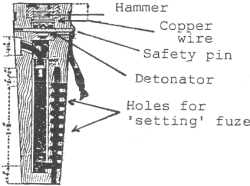The Gun - Rifled OrdnanceRML CartridgesGunpowder remained the sole propellant throughout the RML era until superseded by cordite in 1892. Until 1875 cartridges for RML guns were made of serge but from that year were made of silk cloth with the exception of smaller natures which were made of silk shalloon. A grooved stick ran up the centre of the cartridge to preserve its shape, make handling easy and ensure the circulation of air. Cartridges were divided into three classes: battering, full, and reduced. Battering charges were used with Palliser projectiles and sometimes with common shell, with full for all others. Reduced charges were used for saluting only. IgnitionThis was mainly by friction tube in the field, by electric or percussion tube elsewhere. See "Firing the Gun in the Smoothbore Era". RML FuzesAt first all time fuzes were made of wood to Boxer's pattern and differed little if at all from those designed for SBML equipments (See "Fuzes in the Smoothbore Era"); they were initiated by flash from the propellant charge. However, as effective gas checks came into use, the old types were superseded by fuzes of similar construction but initiated by detonator. | |
|
The safety pin which separated the hammer from the detonator was removed only after the shell had been inserted into the muzzle of the gun. On the gun being fired the hammer set back, sheared the copper wire, and struck the detonator, the flash from which ignited the powder filling which in turn ignited the main shell filling via the hole made in the setting. The older wooden fuzes were hammered into shell with a mallet, but not the new types containing detonators. Gunners had to be instructed to screw these in carefully 'as far as they would go'! When fired at a moderately solid target a common shell fuzed with a wooden time fuze would usually explode, but not on graze. Common shell were still filled with gunpowder. |

Wooden time fuze initiated by detonator |
Percussion FuzesEventually metal percussion fuzes made their appearance. A typical example, shown here, is one made by Armstrong and supplied to the Americans during their Civil War. It was similar to a series made by the Royal Laboratory and in use up to the 1880s. | |
|

Armstrong percussion fuze |
|
Besides being held by the safety pin the plunger 'a' was held by four small lead projections not shown in the drawing. The safety pin was withdrawn only after the shell was inserted into the muzzle. At impact the plunger broke the four lead projections and set forward carrying the detonator on to the striker. The resulting flash ignited the powder 'b' which in turn ignited the fast-burning composition 'i' thence the shell filling. | |
|

The Pettman Land Service fuze. |
|
Designed by Mr Pettman, a Foreman in the Royal Arsenal, the fuze was designed primarily for use with spherical shell fired from SBML guns. It was first only partially effective with RML guns but was improved by later modifications. It was first approved for use in 1861. The ball 'd' is roughened by grooves and is coated with a detonating composition of potassium chlorate, antimony sulphide, sulphur, and mealed powder made into a paste with methylated spirits and shellac. It is covered with gut and varnished silk to keep out damp and to prevent premature explosion. On firing the gun the shock of discharge crushes up the lead cup, the ball, cone plug and steady plug setting back. The steady plug prevent the ball touching the sides as it sets back, and the motion of the shell in the air causes it to disengage from the ball. On the shell hitting the target the ball, now unsupported, is dashed violently against the side of the body, the detonating composition explodes, and the resulting flash ignites the shell filling. WL Ruffell, 2001 previous | index | next | History index | Home | |